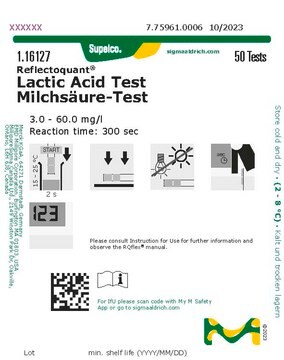MAK058
D-Lactate Colorimetric Assay
sufficient for 100 colorimetric tests
Sinónimos:
D-Lactate Test Kit
Iniciar sesiónpara Ver la Fijación de precios por contrato y de la organización
About This Item
UNSPSC Code:
12161503
NACRES:
NA.84
Productos recomendados
usage
sufficient for 100 colorimetric tests
application(s)
cosmetics
food and beverages
detection method
colorimetric
relevant disease(s)
neurological disorders; gastrointestinal diseases
storage temp.
−20°C
General description
D-Lactate, typically present in the bloodstream at nanomolar concentrations, is produced by an intestinal source or via the methylglyoxal pathway. In mammals, D-Lactate metabolism requires D-Lactate hydrogenase and is metabolized slowly, thus an increase in blood concentration levels can lead to acidemia and acidosis. The severity of this D-lactic acidosis can be associated with neurotoxic symptoms. Significant D-Lactate accumulations in the body can also be related to impaired metabolism and excretion.
Application
D-Lactate Colorimetric Assay kit has been used to determine the stereospecificity of lactate produced.
Suitability
Suitable for use with samples of serum, plasma, cells, culture and fermentation media.
Principle
In this assay, D-Lactate is specifically oxidized by D-Lactate hydrogenase and generates a proportional colorimetric product measured at 450 nm. The useful concentration range in samples is 0.1-10 mM D-Lactate.
signalword
Danger
hcodes
Hazard Classifications
Eye Dam. 1 - Skin Corr. 1B
Storage Class
8A - Combustible corrosive hazardous materials
Certificados de análisis (COA)
Busque Certificados de análisis (COA) introduciendo el número de lote del producto. Los números de lote se encuentran en la etiqueta del producto después de las palabras «Lot» o «Batch»
¿Ya tiene este producto?
Encuentre la documentación para los productos que ha comprado recientemente en la Biblioteca de documentos.
Lucas P Castro et al.
Journal of dairy science, 102(11), 9857-9869 (2019-09-16)
Rehydrated and ensiled mature ground corn has high ruminal starch digestibility, but particle size (PS) and dietary starch proportion (ST) can affect starch digestion and lactating cow performance. We evaluated the effect of rehydrated and ensiled corn (REC), PS, and
Poonam Naik et al.
Current eye research, 45(2), 184-189 (2019-08-31)
Purpose: Microbiological investigations of vitreous fluid have often failed to detect the causative agent in infectious endophthalmitis resulting in a clinical dilemma. D-Lactate is a byproduct of bacterial metabolism, and its accumulation in sterile body fluids indicates bacterial infection. The
Ottavia Benedicenti et al.
Journal of fish diseases, 42(9), 1241-1258 (2019-06-18)
A relationship between increasing water temperature and amoebic gill disease (AGD) prevalence in Atlantic salmon (Salmo salar) has been noted at fish farms in numerous countries. In Scotland (UK), temperatures above 12°C are considered to be an important risk factor
Ayca Erkin-Cakmak et al.
The Journal of clinical endocrinology and metabolism, 104(7), 3003-3011 (2019-03-15)
To investigate the link between dietary sugar consumption and two separate pathogenetic mechanisms associated with metabolic syndrome: de novo lipogenesis (DNL) and nonenzymatic glycation. We assessed changes in serum d-lactate (the detoxification end-product of methylglyoxal) concentration in response to 9
William H. Hoffman et al.
Journal of clinical research in pediatric endocrinology, 12(2), 160-167 (2019-09-14)
To determine the time relationships of soluble receptor for glycation end-products (sRAGE), [a decoy of the advanced glycation end-products (AGE)-RAGE axis] and D-lactate, (a metabolite of methylglyoxal) in the inflammatory response to diabetic ketoacidosis (DKA). Sixteen children and adolescents with
Nuestro equipo de científicos tiene experiencia en todas las áreas de investigación: Ciencias de la vida, Ciencia de los materiales, Síntesis química, Cromatografía, Analítica y muchas otras.
Póngase en contacto con el Servicio técnico


